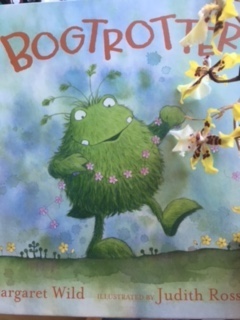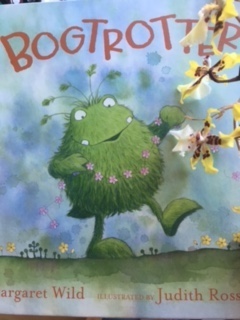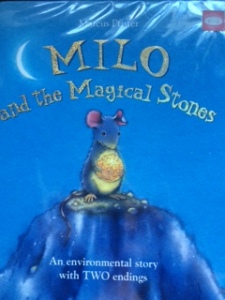What is a Bogtrotter you might ask?

He is a delightful creature that lives in the bog – a gloomy, marshy, mushy bog! Bogtotter, written by Margaret Wild is a book that focuses on belonging, trying new things, playing outdoors, loneliness and discovery.
The illustrations by Judith Rossell are marvellous, really bringing to life the Bogtrotter and his feelings.
The reader steps through into the life of the Bogtrotter, watching him start off doing the same thing every day, not knowing how to make a change. It is through talking to other animals around him and picking a flower that he sees that there is more to his bog.
So how can we use this book?
- Get outside more often. It is easy to be inside with all of the gadgets, toys and applicances but some of these can be used outside too! Grab a pile of books and read them outside, take a picnic blanket onto a small patch of grass and set up some games, eat lunch outside, take photos, pick flowers/grass/leaves! there are so many things we can do outside.
- Learn outside – many teachers spend all the teaching time in the classroom. Is it possible to have at least one lesson outside? Start with one a week then build it up.
- Try something new – even if it is something small, once a week. You are opening yourself up to new experiences which in turn helps your thinking and view of the world.
SUSTAINABILITY
- In order to understand the world and the issues within we need to get out. We need to try new things, read new things and listen to others ideas. Ignorance really is bliss but there is so much out there in the world that by trying something new or listening to someone else’s thoughts actively, we can really make a difference!
LITERACY
Before you read:
What is a Bogtrotter? What is a bog? How will picking a flower change his life?
As you read
Have a set of word cards (see my store) out that can be found during the reading (you may like to read once without the words so children can enjoy the story). As the words are found, discuss the meaning using skills of inferring. Group these words into groups of your choice (verbs, adjectives, feelings etc)
After you read
- Retell the story in your own words using the pictures to help. Which words from the book will help you to tell the story in the most interesting way?
- Why does Bogtrotter only say ‘Ah’ (this allows us to think more, perhaps he only needs to say ah) If you were to re tell this story – would you change this?
- Cycles: Draw up the daily cycle of the Bogtrotter at the beginning of the book. Add to this or draw another to show how his cycle evolved over time. Link this to how we can make small changes in our life to make a difference in how we feel.
- What are the main themes here? See what the children can come up with. Ask them to give examples through words used in the story and images drawn.
- Persuasive text: Why should we make changes? Why should we play and learn outside?
- Link to Choose your own Adventure stories – How can we choose our own adventures? Look at these great planning ideas.
- Thought bubbles: How would we write this as a comic strip or a story which uses thought bubbles? Discuss how thought bubbles can tell a story and create one!
PERSONAL DEVELOPMENT
- Bogtrotter feels lonely but through meeting a frog, he is inspired to make a change. Discuss how children can make changes to their life to improve it. Write down a list of things they would like to change and a plan on how they can change it by themselves or through the help of others. Draw on the importance of community and that loneliness is one of the biggest causes of depression.
LINKS TO CURRICULUM
LITERACY
Discuss characters and events in a range of literary texts and share personal responses to these texts, making connections with students’ own experiences (ACELT1582)
Use comprehension strategies to build literal and inferred meaning about key events, ideas and information in texts that they listen to, view and read by drawing on growing knowledge of context, text structures and language features (ACELY1660)
Create short imaginative and informative texts that show emerging use of appropriate text structure, sentence-level grammar, word choice, spelling, punctuation and appropriate multimodal elements, for example illustrations and diagrams (ACELY1661)
PERSONAL DEVELOPMENT
Describe how respect, empathy and valuing diversity can positively influence relationships (ACPPS037)
Participate in outdoor games and activities to examine how participation promotes a connection between the community, natural and built environments, and health and wellbeing (ACPPS041)
Recognise how media and important people in the community influence personal attitudes, beliefs, decisions and behaviours (ACPPS057)
SUSTAINABILITY
OI.5 World views are formed by experiences at personal, local, national and global levels, and are linked to individual and community actions for sustainability.
OI.7 Actions for a more sustainable future reflect values of care, respect and responsibility, and require us to explore and understand environments.
|
|


